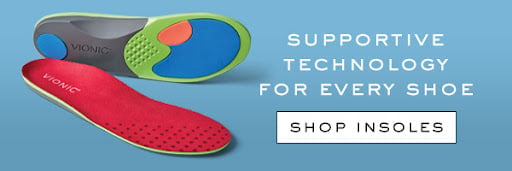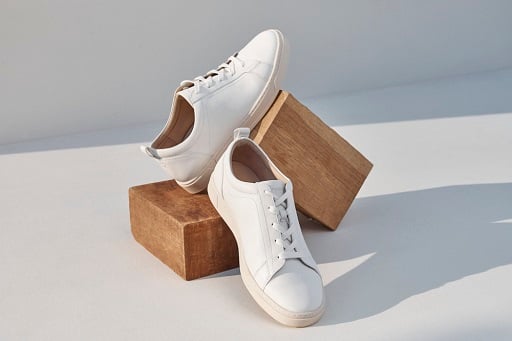Humans typically learn to walk within their first year of life,1 so it makes sense that most of us don’t think about it too deeply—unless the act of walking suddenly becomes painful. According to one study, up to a third of the global population experiences problems like aching, soreness, or stiffness in their feet that can make walking an uncomfortable experience.2
Fortunately, most of these problems are preventable with the right kind of arch support from men and women’s orthotic insoles.
The arch is the area between your heel and the ball of your foot, and it’s naturally raised from the ground in order to support your weight and help you move fluidly. However, arches that are too high or too low can lead to pain and decreased mobility. That’s why assessing your arch height is the first step to maintaining healthy, flexible, and walk-ready feet. And the good news is, doing so is simpler than you might think.
Measuring Your Arch Height: The Wet Test
If you’re one of the thousands of people Googling “do I have flat feet or high arches” in the hopes of finding an answer without having to spend extra time and money on a visit to a podiatrist, you’re in the right place.
The Wet Test is a quick, accurate, and free arch measuring technique that can easily be done in the comfort of your own home to determine whether you have fallen arches or high arches. All you need are two pieces of plain paper (a torn-up brown shopping bag can work nicely in a pinch) and some water.
We recommend performing this test in the bathroom, where you can access water from your shower or sink without making too much of a mess. Once you’re ready, follow these simple steps:
- Place one sheet of paper on the ground.
- Wet the bottom of one foot.
- Step squarely onto the piece of paper to create a print.
- Repeat steps 1-3 with the other foot.
Once you’ve finished, take a step back to admire your art. (You can also take a picture in case your prints start to dry up and disappear.) Then, assess your footprints using the following guidelines:
- The footprint is entirely filled in – If you’re looking at a shape that is filled in enough to look like the insole of your shoe, you have low arches. Many people question, “Are low arches the same as flat feet?” The answer is yes. Fallen arches or flat feet mean that your feet splay when you put weight on them. About a quarter of people have this condition.3
- The footprint is somewhat filled in – A footprint that is not filled in between the ball of the foot and the heel indicates a raised arch. If the area filled in along your midfoot is about half the width of the sole of your foot, this is likely a normal arch.
- The footprint is barely filled in – If your print shows nothing more than your heel, the ball of your foot, and your toes, you have a high arch. If there is a thin line connecting your heel to the rest of your foot, this may still indicate arches that are higher than average. About 20% of people have high arches.4
Remember, everyone’s arches are a little different. However, if you’re wondering, “Why do the arches of my feet hurt?” you probably have high arches or extremely low or flat arches. If you do, it’s a good idea to make sure you’re providing them with the proper amount of support to prevent stiffness, aches, and pain.
What Causes Different Arch Heights?
If you took the Wet Test and learned that your arches are either too high or almost nonexistent, you may be wondering, why are my arches different? Ultimately, arch height varies between individuals, and the exact height of your arches can depend on all kinds of factors, including:
- Genetics
- Injuries
- Weight gain or loss
- Age
Fortunately, there is a solution. By providing your arches with the proper support and treatment, you can prevent or mitigate foot problems. Find out how, below.
Understanding Flat Feet
Flat feet, also known as fallen arches, are almost always present in childhood. This could be due to genetics, tight Achilles tendons, or a general lack of exercise.5 To that end, flat feet can also develop in adulthood.
There are two kinds of flat feet to look out for. These are:
- Flexible flat feet – Raise your foot off the ground and take a look at the arch. If there’s a curve in your feet that disappears when you put weight on it, you have flexible flat feet.
- Rigid flat feet – If you detect no presence of a curve in your foot, even when it’s off the ground, you likely have rigid flat feet.
Common issues resulting from either type of flat foot can include:5
- Inflammation
- Foot and leg cramps
- Knee, hip, or back pain
- Shin splints
- Bunions
- Plantar fasciitis
How to Support Your Flat Feet
If your flat feet aren’t causing you any pain, modifying your activities or booking surgery may not be necessary. However, low-level foot pain, general foot inflexibility, and prevention of future foot conditions are all reasons to learn how to rebuild arches in flat feet and consider taking a few non-invasive steps to support your flat feet. These can include:5
- Providing additional arch support – Supportive insoles can provide extra assistance to the arches, leading to a smoother walking gait and better foot health overall. Even if you don’t need custom orthotics, you should make sure the shoes you wear daily include some form of built-in arch support.
- Performing physical therapy exercises – Learning how to stretch the arches in your feet can strengthen the muscles and ligaments to promote flexibility and ease conditions like plantar fasciitis.6 While you can seek out a physical therapist to build a stretching and strengthening plan, you can also find many useful and simple exercises online with a quick Google search.
- Treating discomfort with NSAIDs – Over-the-counter treatment options like Ibuprofen or Tylenol can help ease occasional inflammation or soreness. You can also try elevating your feet or applying ice packs to reduce swelling and discomfort.
Understanding High Arches
At the other end of the spectrum, individuals with high arches, or cavus foot, also face certain challenges. High arches generally run in the family, but in rare cases, they can also develop as a result of certain health conditions, some of which can be serious. These include:4
- Spina bifida or spinal cord injuries
- Cerebral palsy
- Polio
Like flat feet, high arches aren’t necessarily a problem if you’re not experiencing pain. However, they may lead to uncomfy complications down the road, such as:4
- Inflammation
- Hammer toes
- Unstable ankles
- Hairline fractures in the feet
How to Correct High Arches
Most treatment options for high arches are simple, at-home methods that can go a long way toward easing discomfort. If you want to know how to fix high arched feet, consider these methods:4
- The RICE method – Most high arch pain that comes on after exercise or a long day on your feet can be managed with the RICE method—Rest, Ice, Compression, and Elevation of the feet. If your high arches only occasionally feel stiff or sore, a little extra couch time could also help alleviate symptoms.
- Braces or splints – For more serious foot problems, a healthcare provider may prescribe braces or splints that hold your feet in place and gently stretch the surrounding muscles and ligaments, easing stiffness and inflammation.7
- Arch support – High arches may actually require more support to prevent foot cramps or long-term pain. That’s why flat shoes with little to no support—like stilettos or ballet flats—can wreak havoc on your feet.
How to Find the Right Shoes to Support Your Arches
We’ve mentioned that the right shoes can go a long way toward correcting any issues that may result from arches that are too high or too low. This begs the question, what factors determine the right shoes for my arches?
While a shoe’s arch support plays a huge role, there are other factors to consider when searching for shoes that can offer additional support:
- Stability – Shoes that keep your heel in place can help guide your gait, preventing excess motion that may lead to wobbly ankles or unsteadiness.
- Cushioning – Shoes that have ample padding and shock absorption technology beneath the sole can help decrease fatigue and provide a smooth ride for your feet.
- Flexibility – Look for shoes that allow your foot to move in its natural pattern. This often means a bit of give in the forefoot so that you can push off easily with each step.
Vionic Shoes: For Serious Arch Support
Humans don’t often give much thought to walking, but a lot of coordination needs to happen for you to take a single step—not to mention, to complete more complex movements like running or jumping. If you have arches that are too high or too low, your feet may benefit from additional support to ensure they stay healthy, pain-free, and capable of all types of movement for years to come.
At Vionic, we’ve harnessed science, ingenuity, and input from the medical and athletic communities to develop stylish shoes that offer the cushioning, stability, and flexibility you need to support your arches, no matter their height. In fact, thanks to our exclusive alignment technology, our shoes have been greenlit by the American Podiatric Medical Association, meaning they not only look great, but they also feel great.
Explore our collection today to experience the difference of Vionic shoes yourself.
Sources:
- “When Do Babies Start Walking?” Cleveland Clinic. 22 July, 2022. https://health.clevelandclinic.org/when-do-babies-start-walking/
- Gates, Lucy S et al. “Prevalence of Foot Pain Across an International Consortium of Population-Based Cohorts.” Arthritis care & research vol. 71,5 (2019): 661-670. doi:10.1002/acr.23829
- Pita-Fernandez, Salvador et al. “Flat Foot in a Random Population and its Impact on Quality of Life and Functionality.” Journal of clinical and diagnostic research : JCDR vol. 11,4 (2017): LC22-LC27. doi:10.7860/JCDR/2017/24362.9697
- “High Arch Feet.” Cleveland Clinic. https://my.clevelandclinic.org/health/diseases/21719-high-arch-feet
- “Flat Feet Pain & Treatment.” Advanced Foot & Ankle. https://www.afacc.net/foot-problems/flat-foot/
- “4 Best Exercises for Flat Feet and Fallen Arches.” Cleveland Clinic. 11 March, 2022. https://health.clevelandclinic.org/exercises-flat-feet-fallen-arches/
- Stuber, Kent, and Kevyn Kristmanson. “Conservative therapy for plantar fasciitis: a narrative review of randomized controlled trials.” The Journal of the Canadian Chiropractic Association vol. 50,2 (2006): 118-33.
- “Foot Problems.” Health in Aging. https://www.healthinaging.org/a-z-topic/foot-problems/basic-facts
- Agusala, Bethany. “Focusing on 10,000 steps a day could be a misstep.” UT Southwestern Medical Center. 16 November, 2022. https://utswmed.org/medblog/how-many-steps-per-day/





Leave a Reply